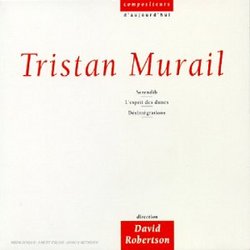| All Artists: Ensemble InterContemporain Title: Tristan Murail-Serendib-L'Esprit des Dunes-DeSinte Members Wishing: 1 Total Copies: 0 Label: Musidisc Release Date: 10/12/1999 Album Type: Import Genre: Classical Style: Number of Discs: 1 SwapaCD Credits: 1 UPC: 028946530528 |
Search - Ensemble InterContemporain :: Tristan Murail-Serendib-L'Esprit des Dunes-DeSinte
 | Ensemble InterContemporain Tristan Murail-Serendib-L'Esprit des Dunes-DeSinte Genre: Classical |
Larger Image |
CD DetailsSimilar CDs |
CD ReviewsA mixed programme of one masterpiece and two works of much l Christopher Culver | 11/14/2009 (3 out of 5 stars) "This Accord CD features performances of three pieces by Tristan Murail recorded at IRCAM in the early 1990s. David Robertson leads the Ensemble Intercontemporain.
"Desintegrations" for ensemble and tape (1983) is one of the great spectralist masterpieces, endlessly studied and called by many later composers a milestone in new music. As the title suggests, the musical material is based entirely on sound spectras. Murail decomposed various instrumental sounds (especially piano, brass and cello) into their overtones, and then assigned these to the performers, while the tape part is based on artificial spectra generated by electronics. The result is a massive sound mass, sure to appeal to fans of Xenakis and Ligeti. It's quite varied too, with among many other things lovely section of bell chimes, some crunching orchestral sounds, and an ear-tickling exhibition of interference tones. This recording beats that by the Ensemble L'itinerarire on an Naive disc. Murail's second IRCAM commission was "L'Esprit des dunes" for ensemble and live electronics (1992). A portrait of the desert with its soft woodwind drifts, the piece is also based on analysis of recordings of traditional music from Tibet, including their remarkable trumpets and drums, and from Mongolia, where one finds the jew's harp and overtone singing. One immediately notices here more melodic writing, as the piece opens with a sinuous oboe line. Ultimately this is a piece that fascinates me and which I'd really like to like, but I just can't seem to get into it. Some of the electronic transformations are interesting, but Murail's inspirations don't seem integrated well into the final form, and the piece just sort of meanders. "Serendib" for orchestra (1992) is a bit better, a constant flurry. Still, I sometimes feel that Murail is just repeating the gestures of "Desintegrations" without moving towards something boldly new. Julian Anderson contributes very informative liner notes -- he's one of the most perceptive commentators on the spectralist scene." |

